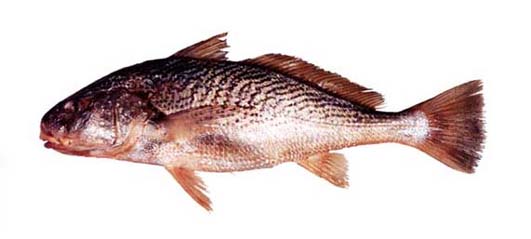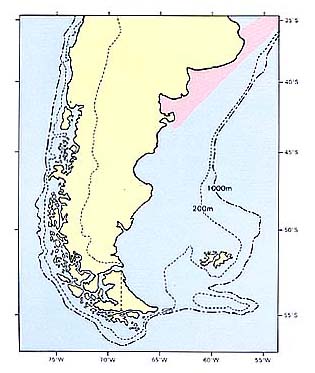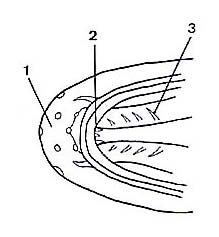ニベ科
ニベ科(Sciaenidae)

83 セマルニベ(Semaru-nibe)
Micropogon furnieri (Desmarest, 1823)
Whitemouth croaker (En.); Tambour raye (Fr.); Corvinón rayado (Sp.); Corvina(Arg.)
特 徴:
背鰭11棘,27~30軟条,臀鰭2棘,7~9軟条,胸鰭18~19軟条,腹鰭1棘,5軟条,有孔側線鱗数50~54,鰓耙数7~9+14~16=22~29。体長に対する体高の割合は28.6~30.2%,頭長は31.1~33.1%,眼径は4.1~4.4%,両眼間隔は8.1~9.0%,吻長は11.0~11.6%,上顎長は10.9~11.4%,尾柄高は7.8~9.0%,胸鰭長は22.6~25.2%,腹鰭長は18.0~20.1%。体はやや延長し,中庸に側扁する。背鰭は深い欠刻を有し,軟条部の最前部に1棘がある。尾鰭後縁はやや突出する。前鰓蓋骨隅角部に3~5本の棘がある。口は下位でほぼ水平。両顎歯は絨毛状で,歯帯を形成する。下顎の内側に沿って3~5対の小さな髭がある。吻に7~8個の孔がある。体と頭部背面の鱗は櫛鱗で,吻,ほほおよび鰓蓋域の鱗は円鱗。背鰭起部から側線までの横列鱗数は6~7。側線は尾鰭後縁まで延長する。体は銀色で,金色の光沢をおびる。体側背方はやや灰色をおびる。体側上部に多数の細い暗色の斜縞があり,体の前方では側線下方までやや延長する。背鰭棘条部に暗色斑点はみられない。
分 布:
大部分のアンチル諸島とカリブ海南部の沿岸域および南米大西洋岸のコスタリカからアルゼンチン北部にかけて分布する。普通,水深60m付近までの沿岸域の砂泥底に生息する(Chao, 1977)。
備 考:
最大体長60cm,通常45cm。本種は東部大西洋に分布するM. undulatasに非常によく似ているが,側線上の横列鱗数や体の縞紋様により区別される(Chao, 1977)。
(稲田伊史)
Material examined:
4 from Argentina (339-417 mm SL), FSFL EM 415, 418, 420, 635.
Description:
D Ⅹ,Ⅰ, 27-30; A Ⅱ, 7-9; P1 18-19; P2 Ⅰ, 5; LLS 50-54; GR 7-9+14-16=22-29. HL 31.1-33.1% of SL; ED 4.1-4.4; BD 28.6-30.2; SN 11.0-11.6; IO 8.1-9.0; UJ 10.9-11.4; CP 7.8-9.0; P1L 22.6-25.2; P2L 18.0-20.1; PreD 38.5-39.6.
Body Slightly elongate, moderately compressed. Dorsal fin with a deep notch; a short spine anterior to second dorsal fin. Caudal margin slightly convex. Preopercular margin serrated, with 3 to 5 spines at angle. Mouth inferior, nearly horizontal; teeth villiform, forming bands in both jaws, outer row in upper jaw slightly enlarged. Chin with 3 to 5 pairs of small barbels along inner edge of lower jaw; snout with 7 to 8 pores. Gill-rakers short and tough. Scales ctenoid on body and top of head; cycloid on snout, cheek and opercle; 6 or 7 scales between dorsal fin origin and lateral line in vertical series; lateral line extending posterior margin of caudal fin. Body silvery with a golden cast, back greyish, with distinct oblique dark streaks along scale rows extending to much below lateral line; spinal portion of dorsal fin without small dark dots.
Distribution:
Most of the Antilles and along the southern Caribbean coast and the Atlantic coast of South America from Costa Rica to Argentina. Found usually over muddy and sandy bottom in the coastal waters to about 60 m depths (Chao, 1977).
Remarks:
Attains 60 cm SL, common to 45 cm SL. This species is very similar to M. undulatus (junior synonym: M. opercularis) in the western Atlantic, but differs by characters of the number of vertical scales between dorsal fin origin and lateral line, and the color pattern of fins and body (Chao, 1978).
(Tadashi INADA)

Distribution of Micropogon furnieri in Patagonia.

Ventral view of head. Snout (1), mental pore (2) and barbel on chin (3).